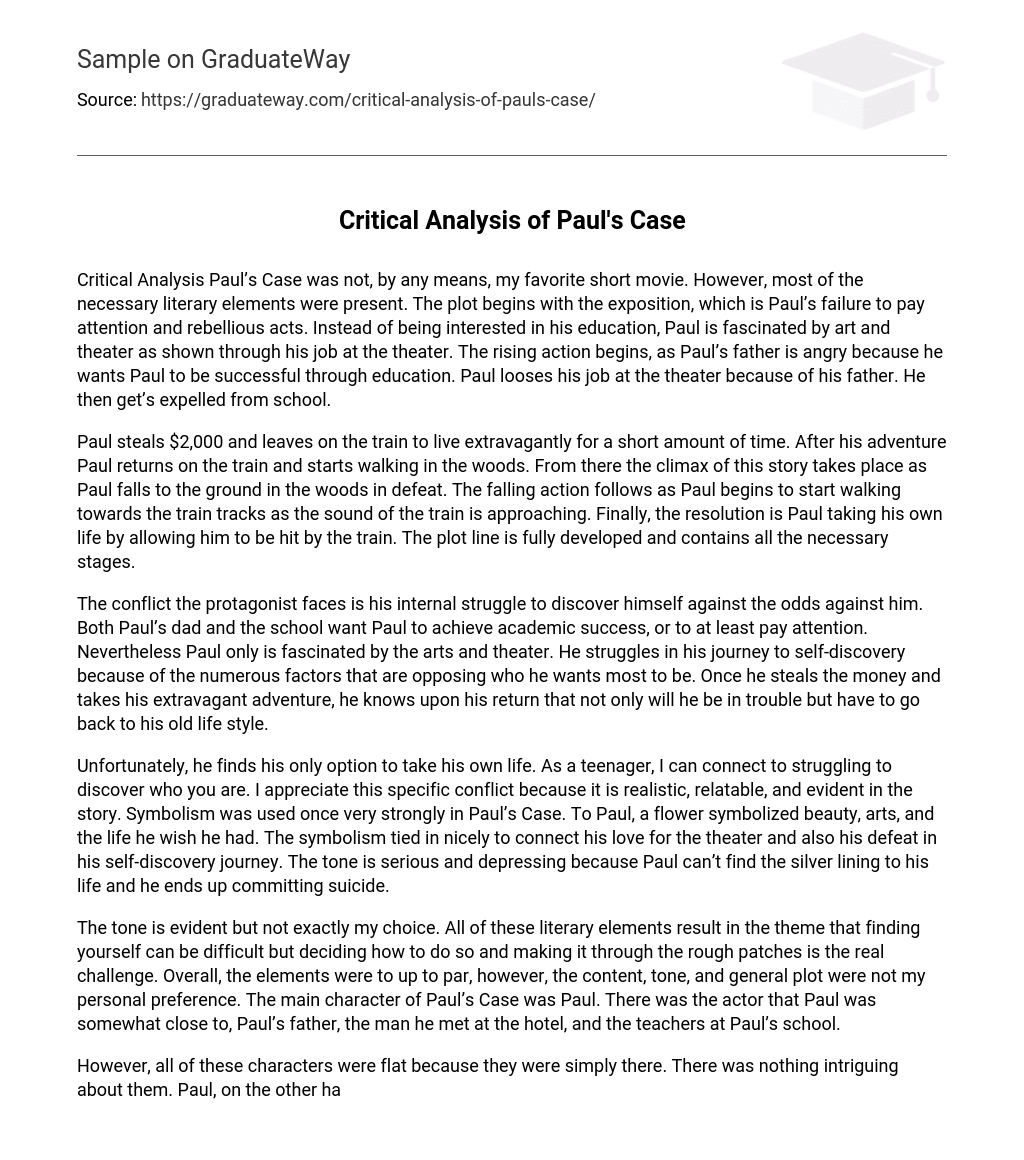Critical Analysis Paul’s Case was not, by any means, my favorite short movie. However, most of the necessary literary elements were present. The plot begins with the exposition, which is Paul’s failure to pay attention and rebellious acts. Instead of being interested in his education, Paul is fascinated by art and theater as shown through his job at the theater. The rising action begins, as Paul’s father is angry because he wants Paul to be successful through education. Paul looses his job at the theater because of his father. He then get’s expelled from school.
Paul steals $2,000 and leaves on the train to live extravagantly for a short amount of time. After his adventure Paul returns on the train and starts walking in the woods. From there the climax of this story takes place as Paul falls to the ground in the woods in defeat. The falling action follows as Paul begins to start walking towards the train tracks as the sound of the train is approaching. Finally, the resolution is Paul taking his own life by allowing him to be hit by the train. The plot line is fully developed and contains all the necessary stages.
The conflict the protagonist faces is his internal struggle to discover himself against the odds against him. Both Paul’s dad and the school want Paul to achieve academic success, or to at least pay attention. Nevertheless Paul only is fascinated by the arts and theater. He struggles in his journey to self-discovery because of the numerous factors that are opposing who he wants most to be. Once he steals the money and takes his extravagant adventure, he knows upon his return that not only will he be in trouble but have to go back to his old life style.
Unfortunately, he finds his only option to take his own life. As a teenager, I can connect to struggling to discover who you are. I appreciate this specific conflict because it is realistic, relatable, and evident in the story. Symbolism was used once very strongly in Paul’s Case. To Paul, a flower symbolized beauty, arts, and the life he wish he had. The symbolism tied in nicely to connect his love for the theater and also his defeat in his self-discovery journey. The tone is serious and depressing because Paul can’t find the silver lining to his life and he ends up committing suicide.
The tone is evident but not exactly my choice. All of these literary elements result in the theme that finding yourself can be difficult but deciding how to do so and making it through the rough patches is the real challenge. Overall, the elements were to up to par, however, the content, tone, and general plot were not my personal preference. The main character of Paul’s Case was Paul. There was the actor that Paul was somewhat close to, Paul’s father, the man he met at the hotel, and the teachers at Paul’s school.
However, all of these characters were flat because they were simply there. There was nothing intriguing about them. Paul, on the other hand was very round. He was a developed character. We knew learned through his actions and words that he was rebellious, fascinated by the arts, hated school, and incisive about what to do with his life. He was distracted easily and had a poor relationship with his father. He was characterized well. However, my problem with Paul is that he is neither static nor a dynamic character.
We know that he changed slightly from being unhappy with his life to being so miserable that he felt the need to take his own life. But at the same time this could have been his initial intent from the beginning and it took until the end of the movie for him to get up the courage to take action. We don’t know the reason behind his initial struggles to onset his hate for working and school. Whether it was the death of his mother or a violent past, we will never find out. There is not enough information of his previous state to know if he changed or not.
Though the characterization of Paul was done well because he was well developed, he was neither static nor dynamic resulting in a fault with the characterization. In this case of the short movie, imagery was used to appeal to our sense of hearing. It helped to add to the suspense of the climax, falling action, and resolution. During the climax the strange, loud noises aided to Paul’s realization that he was giving up. As the train approaches, the loud horn resembles how Paul chooses to end his life.
It adds suspense and drama to the scene and ends the story with a sense of closure. The overall organization was for the most part. However, in the exposition, we need a more clear reason to why Paul has such internal problems. Structurally, the rest of the play had sufficient transitions throughout the steps of the plot structure. Nothing felt choppy or rushed and the overall plot had a pleasant flow. There was a long enough amount of time during the rising action to explain why Paul felt he could not continue on because he was so happy with his life.
Through his expulsion from school, crime where he stole the money, and running away from home, we understand why he felt he didn’t have anything to live for. The climax was supported well through the symbolism of the flowers but why he was eating snow is beyond me. The falling action as the train horn is sounding is dramatic and suspenseful. Lastly, I feel in the resolution it was a good choice to not actually show Paul getting hit by the train. In all, the imagery which helped the organization of this play was sufficient.





